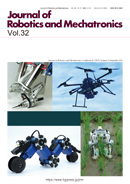32 巻, 4 号
選択された号の論文の15件中1~15を表示しています
- |<
- <
- 1
- >
- >|
Review on Autonomous Underwater Vehicle in Japan
-
原稿種別: Review
2020 年 32 巻 4 号 p. 713-721
発行日: 2020/08/20
公開日: 2020/08/20
PDF形式でダウンロード (7330K)
Special Issue on Brain Machine/Computer Interface and its Application
-
原稿種別: Editorial
2020 年 32 巻 4 号 p. 723
発行日: 2020/08/20
公開日: 2020/08/20
PDF形式でダウンロード (246K) -
原稿種別: Paper
2020 年 32 巻 4 号 p. 724-730
発行日: 2020/08/20
公開日: 2020/08/20
PDF形式でダウンロード (659K) -
原稿種別: Paper
2020 年 32 巻 4 号 p. 731-737
発行日: 2020/08/20
公開日: 2020/08/20
PDF形式でダウンロード (320K) -
原稿種別: Paper
2020 年 32 巻 4 号 p. 738-744
発行日: 2020/08/20
公開日: 2020/08/20
PDF形式でダウンロード (1419K) -
原稿種別: Paper
2020 年 32 巻 4 号 p. 745-752
発行日: 2020/08/20
公開日: 2020/08/20
PDF形式でダウンロード (1438K) -
原稿種別: Paper
2020 年 32 巻 4 号 p. 753-760
発行日: 2020/08/20
公開日: 2020/08/20
PDF形式でダウンロード (1607K) -
原稿種別: Development Report
2020 年 32 巻 4 号 p. 761-767
発行日: 2020/08/20
公開日: 2020/08/20
PDF形式でダウンロード (1010K)
Regular Papers
-
原稿種別: Paper
2020 年 32 巻 4 号 p. 769-779
発行日: 2020/08/20
公開日: 2020/08/20
PDF形式でダウンロード (882K) -
原稿種別: Paper
2020 年 32 巻 4 号 p. 780-788
発行日: 2020/08/20
公開日: 2020/08/20
PDF形式でダウンロード (1610K) -
原稿種別: Paper
2020 年 32 巻 4 号 p. 789-797
発行日: 2020/08/20
公開日: 2020/08/20
PDF形式でダウンロード (5208K) -
原稿種別: Paper
2020 年 32 巻 4 号 p. 798-811
発行日: 2020/08/20
公開日: 2020/08/20
PDF形式でダウンロード (3487K) -
原稿種別: Paper
2020 年 32 巻 4 号 p. 812-821
発行日: 2020/08/20
公開日: 2020/08/20
PDF形式でダウンロード (1220K) -
原稿種別: Paper
2020 年 32 巻 4 号 p. 822-831
発行日: 2020/08/20
公開日: 2020/08/20
PDF形式でダウンロード (1092K) -
原稿種別: Development Report
2020 年 32 巻 4 号 p. 832-839
発行日: 2020/08/20
公開日: 2020/08/20
PDF形式でダウンロード (4348K)
- |<
- <
- 1
- >
- >|
